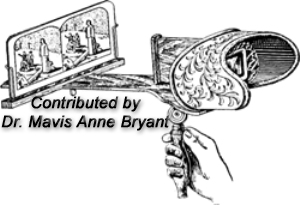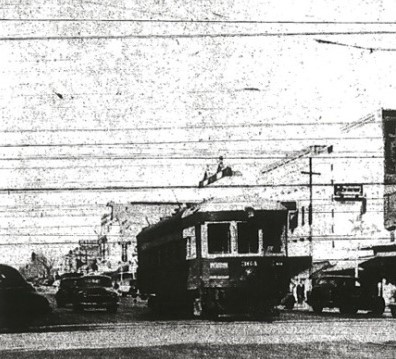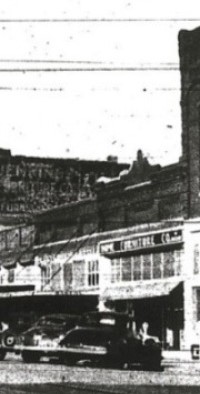|
The Interurban
Denison Herald
Sunday, March 25, 1990 The interurban: First in Texas by Calvin Mauldin Iron wheels and steel tracks have been part of Denison's history since its birth in 1872 when the first Katy steam locomotive crossed Red River, chugged up the long hill and stopped at the new town site 6 miles ahead. As Denison grew, the need for intercity transportation became apparent. The Denison Street Railway system was put into operation sometime in the 1880s. Consisting of small, wooden coaches that were fully enclosed for passenger comfort, the cars were pulled along steel rails by 2 mules. The mule powered coaches obviously were not fast, but they were dependable. J.P. Cearer took over the system's operation in 1896. He brought with him dreams of plans for the future, such as an electrically powered railway system that would not only run in Denison, but extend to Sherman. By 1899, city engineer R.L. McWilley had completed the survey of the route between Sherman and Denison. Fred Fred Fitch, civil engineer and general manager of the newly formed Denison and Sherman Railway Co., began the line's construction. On May 1, 1901, the first interurban put into operation in Texas rolled out of Denison on its maiden voyage to Sherman. For turn of the century Denisonians this was a day of celebration. Bands played, politicians gave speeches, and everyone marveled at this new example of 20th century progress. As with anything new and unproven the first few months of operation were plagued with equipment failures. The power lines carrying 15,000 volts of electrical current would break and the electric motors on the cars would often short out and refuse to run. But as time went by the bugs were worked out. The early interurban was such a success that by April 16, 1911, service was extended to Dallas; then by January 1, 1917, lines were added to run to Waco and Corsicana. Along with all the expansion, the company name was changed to the Texas Electric Railway. Throughout the teens and 1920s the interurban yielded large profits, not only from passenger fares, but from freight hauling. However by 1935, Texas Electric Railway was in serious financial straits, resulting in it being reorganized under Section 77B of the Federal Bankruptcy Act. The enemy to the interurban operation was progress of another type: improved highways, buses, faster, more comfortable automobiles and motor freight lines. The interurban was a business, but to many Denisonians it was much more. Eighty-four year old, L.J. Stephens, former motorman for Texas Electric Railway remembers, "It was a hard job. At times I worked a lot of 16-hour days and most of the time, 7 days a week. During the war I had 3 days off in 3 years, but being a motorman was a real adventure. I remember being between Sherman and Denison on the way in when that big ice storm hit back in the '40s. The power lines broke from the weight of the ice, and we were stranded with no heat or lights. I had to walk over a mile to get to the dispatch phone booth and call for help. I think it was nearly 3 hours before the road crew could get to us." 
Stephens laughs as he remembers Woodlak Park, between Sherman and Denison (now virtually abandoned). "In the summertime the interurban would be loaded with fares going to Woodlake, especially on the Fourth of July for fireworks. The car normally held 47 people, but on these runs we packed them in, standing room only!" Unusual accidents could take place while piloting a 47,000-pound interurban car. One such incident happened to E.E. Summers in the late 1930s as he began his early morning run. As he turned up Main Street heading west, he was startled by the sight of 30 elephants lined up straight along the sidewalk in front of the Saratoga Cafe at 101 W. Main. The Ringling Brothers Circus had just arrived and handlers had unloaded the elephants for exercise. The handlers motioned for Summers to go on by. He passed 6 of the pachyderms before number 7 became frightened and backed in front of the car. No injuries resulted, but the elephant probably never forgot the impact. With the outbreak of World War II, the Texas Electric Railway enjoyed a brief resurgence of popularity, thanks in part to gas and tire rationing. The huge red-and-yellow interurbans continued their 5:30 a.m. to 10:30 p.m. schedule with cars coming in and going out every hour. With the war came the construction of Perrin Field. In a round-about way this also added to the fare receipts, for many of the airmen had never seen an interurban, let alone ridden one. As one motorman put it at the time, "these boys got on with all the enthusiasm of a kid on his first ferris wheel ride. You can't imagine all the questions they ask." The price for a ticket: a nickel! Woodlake was 15c and Dallas $1.84. Sadly after 47 years and 7 months, the Texas Electric Railway made its last run out of Denison, December 31, 1948. The decline in fares increased once more after the war. Coupled with payments for damages and injuries in collisions, such a s the one near Woodlake, the interurban was sent to the brink of financial ruin once more. At 11 p.m. December 31, 1948, W.V. Taylor purchased the last ticket sold on the Houston street station, boarded the interurban with 40 other passengers and traveled what retired Denison Herald editor Claud Easterly called a "sentimental Journey." With motorman H.B. Andrews at the controls, the interurban motored out South Mirick and into transportation extinction. Earlier that evening, perhaps sensing history in the making, a crowd gathered at the Houston avenue station. Some wouldn't ride any father than Mirick Avenue, but the more enthusiastic went on to Sherman. A few stayed on to the end of the line in Dallas. "For me it was a night of mixed emotions," recalls Stephens, "I was sad that this was it, but relieved that it was over. What was ironic and kind of funny was after my last run to Dallas, I had to take a bus back to Denison as a passenger." At midnight, December 31, the majority of Denison's Texas Electric Railway employees were out of work. Salvage operations began promptly at 7 a.m. the next morning with workers dismantling power lines on Mirick. The 26 passenger cars and 29 express cars from all area lines were "deadheaded" into Dallas where they would be stored until they could be sold for salvage or used as roadside diners or even as home. The Texas Electric Railway hoped to get at least $100 for the 450-square foot coaches. Buses took over as Denison's public conveyance. Titled "The City Transit Company," an offshoot of the Texas Electric Railway, the bus service could be routed to reach more fares than the interurban. Today there is very little visible evidence that the interurban ever ran through Denison. A short section of track still in place at the Houston Avenue station site is all that is left as a reminder. The salvage crew was very efficient. In dismantling the operation hundreds of miles of steel rails were pulled up and sold to rolling mills. Nearly 200,000 cross ties were recovered and purchased by other railroads. Smelters got the bulk of thousands of miles of copper power lines. The majority of the line's electric substations were bought by the Illinois Terminal Railway and the rest going to West Virginia coal mines. Depots and other real estate holdings were put on the market and sold. Fortunately, a commodity that couldn't be dismantled and hauled away were memories. Anyone 45 years old or younger possibly has no recollection of the interurban, but if you're curious, as mom and dad, or the keepers of history treasures, grandma and grandpa. Chances are they'll tell about riding the interurban into town on their first date, or about the summer the family rode out to Woodlake Park for a picnic, or that first trip to Dallas. Have some spare time when you do this, because you'll also get some details of how it felt getting on the huge, red-and-yellow interurban, sitting down on the brown leather-covered seats, and riding south on Mirick Avenue, hearing the click-clack of the iron wheels as they rolled across the joints of the steel rails. They'll tell of the sound of the motorman's foot-operated warning bell that clanged loudly at ever crossing and how sometimes he had to use an odd-sounding whistle to alert an unwary motorist to clear the roadway. And how the car rocked from side to side as it picked up speed (20 mph in town and 45 mph in open country). If you look into the eyes of a story teller, you'll notice the affection he still has for the old interurban. As the tale comes to an end, your feeling will be one of overwhelming envy. Envy, because you never got to experience the thrill of riding on Texas' first-ever electric railway. (Virginia Thompson Reynolds, Ernest Shields and L.J. Stephens contributed to this story.) 

History of Texas Electric Railway Company Transportation Copyright © 2025, TXGenWeb. If you find any of Grayson County, TXGenWeb links inoperable, please send me a message. |

